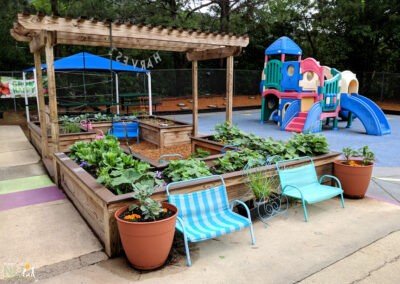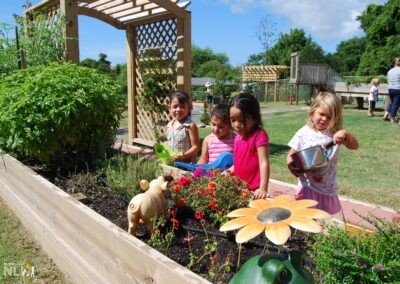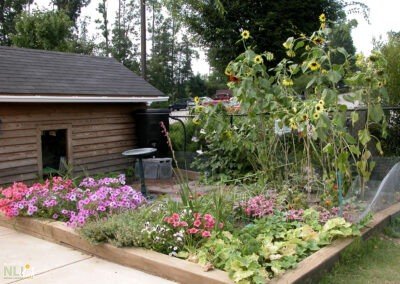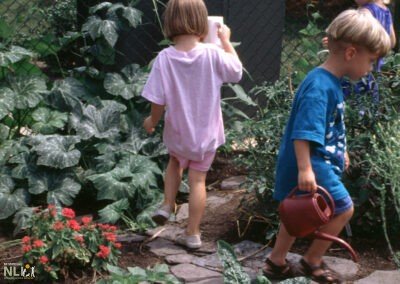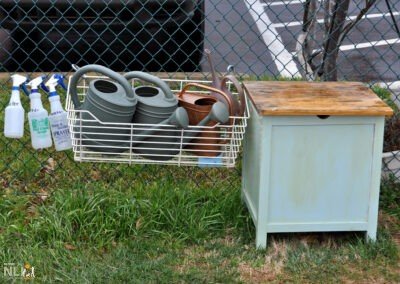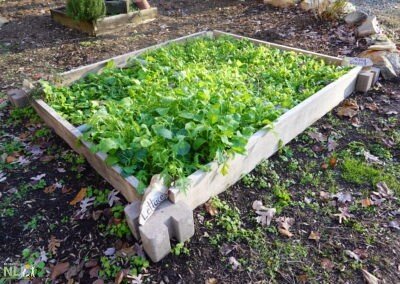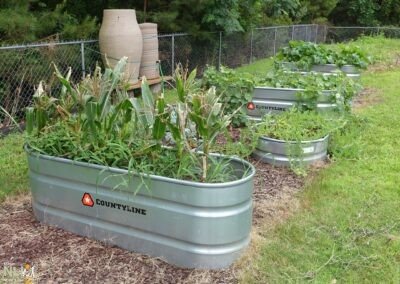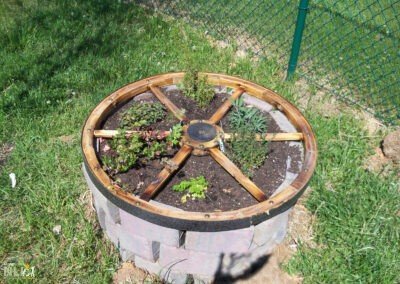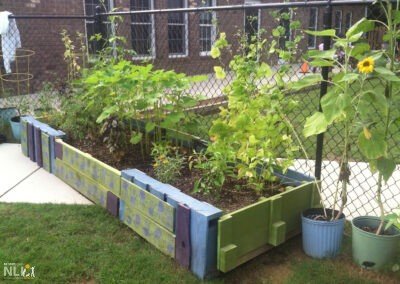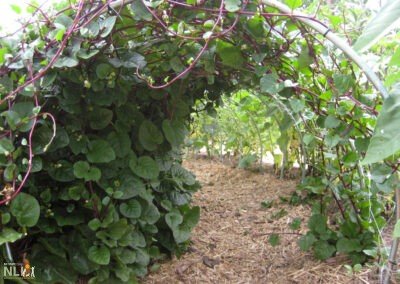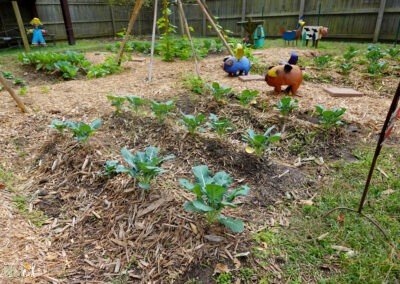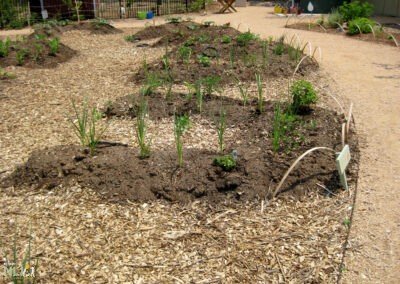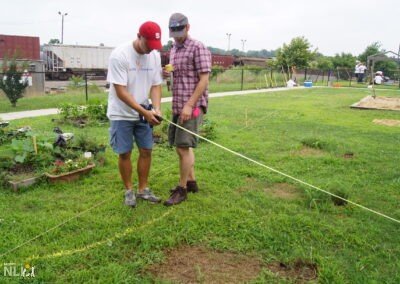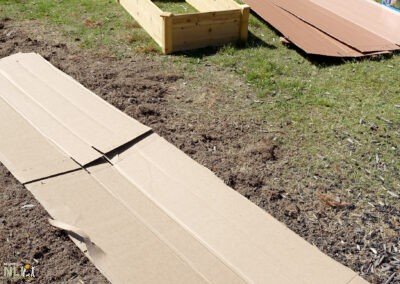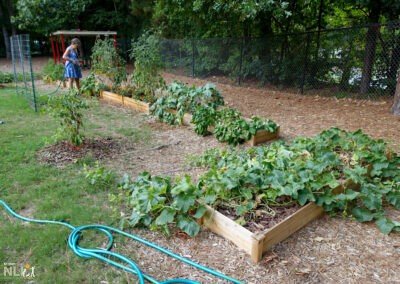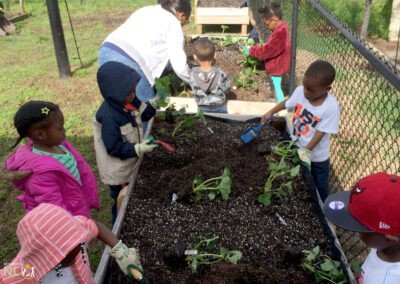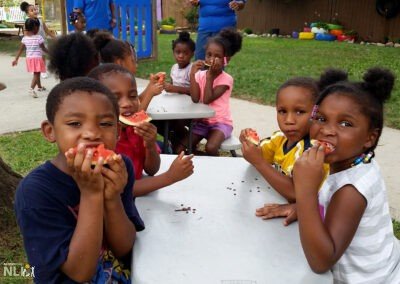Infosheets
24. Early Childhood Fruit and Vegetable Gardens
Children’s fruit and vegetable gardening can be supported by several garden types. If prior experience is lacking, container gardening is a great, confidence-building initial step. Failure is impossible if the basics are followed: fertile planting soil, sunny location, regular watering, and hardy plants like tomatoes and basil. Gardening and eating are highly sensory experiences, which in time help young children understand what plants need to thrive. Everyone, teachers and children alike, learn gardening through direct, hands-on observation and experimentation. Along the way, children also learn that caring for nature has positive results. When children grow their own food, they are more motivated to taste, eat, and enjoy the fruits and vegetables of their labor. Intentional garden planning, design, and installation will provide endless opportunities to enrich the learning environment – and potentially influence home cooking! Consider also the garden as a social/gathering setting, where users learn, share across generations, and relax, immersed in nature.
Key factors determining fruit and vegetable gardening success:
Starting Indoors. Start vegetables indoors from seed so that children experience the miracle of seed germination as the first step in the gardening process. Indoors offers an early start before the last frost. Once that risk has passed, seedlings can be gradually “hardened” before transplanting into containers or beds. For more information, refer to Making Newspaper Seedling Pots, InfoSheet #18, Starting Veggies Indoors, InfoSheet #19, and Indoor Plants for Homes and Classrooms, InfoSheet #20.
Sun. Locations should receive full sun for most of the day, throughout the year. Typically, fruit and vegetables require a minimum of 6 hours/day with 8 to 10 hours being ideal.1 Locate the garden away from trees and avoid the north side of buildings and structures. A flat, accessible space that receives afternoon sun is usually ideal for gardening.
Soil. Fruit and vegetables require nutrient-rich, well-draining soil. As childcare center sites often lack these requirements, contact local cooperative extension offices. They can provide soil sampling services to determine soil quality, advise on amendments, and if necessary share information about local suppliers.
Water. Gardens need to be close to a water source to minimize the burden of garden maintenance. If necessary, a hose can be run along fence lines from the hose bib to the garden. Important accessories are a hose bib key and a watering wand.
Location. Select a flat area with sufficient sun exposure, close to a water source, and easily accessible from classrooms. Classroom adjacency eases daily watering and checking for weeds, and makes possible daily observation of beneficial insects as well as those that might attack ripening produce. If possible, locate gardens away from high-traffic, active play spaces to help protect fragile plants. Position gardens backed by fence lines or sheltered in corners to prevent “run-throughs” by children. Fences offer vertical support for vines such as cucumbers and pole beans. Consider arbors, pergolas, trellises, and ribbed tunnels for the same purpose, including perennial vines such as thornless blackberries and grapes to immerse children in living, green settings. For more information, refer to Arbors, Pergolas & Trellises, InfoSheet #12.
Storage. Adjacent storage is needed for ancillary items including hand tools, gardening gloves, watering cans and wands, stakes, and ties. A deck box or outdoor or waterproof coffer can serve this purpose. If possible, store spare soil and mulch in a nearby, larger storage unit. A potting shed, with sunny windows and/or roof lights for seedlings, may match equivalent gardening ambitions!
Garden Types
Consider gardening as a flexible process, modestly initiated and annually expandable. Experienced, confident gardeners may start with a fully-fledged installation. Whatever the starting point, by any measure gardening is a cost-effective investment for achieving healthy eating outcomes.2 Common garden types include:
Container Gardening. Container gardening provides an affordable, flexible first step for engaging children in the growing process. The great advantage of container gardening is the flexibility offered by movable, expandable containers. Bigger is better for plant growth and water retention. Container gardens offer snacking and in sufficient numbers may contribute produce to center meal programs. For more information, refer to Growing Edibles in Containers, InfoSheet #10.
Straw Bale Gardening. Straw bale gardening provides a fun, fascinating, ephemeral, raised bed gardening option using the harvested by-product of grain production. For more information, refer to Straw Bale Planters, InfoSheet #23.
Raised-Bed Gardening. Raised bed gardening installations range from modest, single-board frames that can last for years, to more elaborate multi-board options. Raised beds have more soil depth for plant roots, hold more moisture, and are easier to work with for standing children and adults. Raised beds offer the benefits of size, production capacity, and engagement of more children. In sufficient numbers, raised-bed gardens can contribute substantially to center meal programs.
In-Ground Gardening. In-ground gardening uses beds directly in the ground, offering room for sprawling plants such as sweet potatoes, summer squash, melons, cantaloupe, and pumpkins. In-ground gardens take two basis forms: linear beds, with access paths between; and flexible walk-in beds of varied shapes and sizes. Either form may contribute substantially to center meal programs.
Layout
Once the garden location has been selected, the number, size, spacing, and layout of containers or garden beds can be decided. Design tips include:
- Cut and tape together sections of recycled cardboard to match the size of bed footprints. Move cardboard footprints around until the desired layout is achieved. Use spray chalk (available at hardware stores), to mark bed outlines before removing the cardboard.
- Keep beds narrow so that children can reach into the middle from both sides (3 feet wide works best, 4 feet maximum).
- Space garden beds far enough apart to allow room for children to walk between them (2 to 3 feet is good, 18 inches minimum).
Planting
For centers in southern latitudes, to maximize the health benefits of garden space and provide year-round learning opportunities, consider gardening in the spring, summer, and fall seasons. Refer to the resources below for lists of warm and cool-season vegetables, growing recommendations, and planting calendars. Local cooperative extension agents or nurseries can provide regional seasonal planting guides.
Management
Soil moisture levels are best checked by regularly feeling by hand if the soil is moist. Maintaining 2-3 inches of mulch will help retain moisture and also prevent weeds. Pull weeds (anything that is not a fruit or vegetable) as needed. Keep weeds out of adjacent pathways and mow grass to prevent it from spreading into the garden. Add one to three inches of compost to beds annually to replenish soil nutrients.
Resources:
- Arbors, Pergolas & Trellises, InfoSheet #12. https://naturalearning.org/12-arbors-pergolas-&-trellises
- Gardening Activity Guide, https://naturalearning.org/gardening-series
- Growing Edibles in Containers, Infosheet #10. https://naturalearning.org/growing-edibles-in-containers
- Indoor Plants for Homes and Classrooms, InfoSheet #20. https://naturalearning.org/20-indoor-plants-for-homes-and-classrooms
- Local Foods: Childcare Center Production Gardens Series, https://naturalearning.org/gardening-series
- Making Newspaper Seedling Pots, InfoSheet #18. https://naturalearning.org/18-newspaper-pots/
- NCSU Cooperative Extension, Gardener Handbook, https://content.ces.ncsu.edu/extension-gardener-handbook
- NCSU Cooperative Extension, Gardening Plant Calendar, https://extensiongardener.ces.ncsu.edu/NC-Vegetable-Planting-Guide
- Starting Veggies Indoors, InfoSheet #19. https://naturalearning.org/19-starting-veggies-indoors/
- Straw Bale Planters, InfoSheet #23. https://naturalearning.org/23-straw-bale-planters
Resources
¹ Gunter, C. 2018. Vegetable Gardening (Ch. 16). In K.A. Moore and L.K. Bradley (eds). North Carolina Extension Gardener Handbook. NC State Extension, Raleigh, NC. http://content.ces.ncsu.edu/16-vegetable-gardening
² Cosco NG, Wells NM, Zhang D, Goodell LS, Monsur M, Xu T and Moore RC (2022) Hands-on childcare garden intervention: A randomized controlled trial to assess effects on fruit and vegetable identification, liking, and consumption among children aged 3–5 years in North Carolina. Front. Psychol. 13:993637. 10.3389/fpsyg.2022.993637

